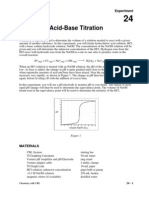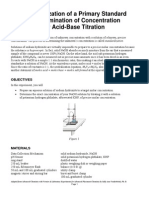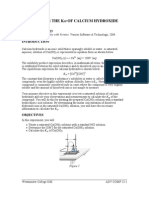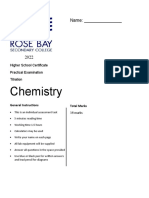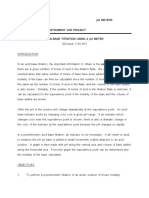25 Titration Diprotic Acid
25 Titration Diprotic Acid
Uploaded by
Angel DediosCopyright:
Available Formats
25 Titration Diprotic Acid
25 Titration Diprotic Acid
Uploaded by
Angel DediosCopyright
Available Formats
Share this document
Did you find this document useful?
Is this content inappropriate?
Copyright:
Available Formats
25 Titration Diprotic Acid
25 Titration Diprotic Acid
Uploaded by
Angel DediosCopyright:
Available Formats
Computer
Titration of a Diprotic Acid:
25
Identifying an Unknown
A diprotic acid is an acid that yields two H+ ions per acid molecule. Examples of diprotic acids
are sulfuric acid, H2SO4, and carbonic acid, H2CO3. A diprotic acid dissociates in water in two
stages:
(1) H2X(aq) ← → H+(aq) + HX–(aq)
(2) HX–(aq) ← → H+(aq) + X2–(aq)
Because of the successive dissociations, titration curves of diprotic acids have two equivalence
points, as shown in Figure 1. The equations for the acid-base reactions occurring between a
diprotic acid, H2X, and sodium hydroxide base, NaOH, are
from the beginning to the first equivalence point:
(3) H2X + NaOH ← → NaHX + H2O
from the first to the second equivalence point: pH
(4) NaHX + NaOH ← → Na2X + H2O
from the beginning of the reaction through the
second equivalence point (net reaction):
(5) H2X + 2 NaOH ← → Na2X + 2 H2O 1st Equivalence Point 2nd Equivalence Point
Volume NaOH
At the first equivalence point, all H+ ions from
the first dissociation have reacted with NaOH Figure 1
+
base. At the second equivalence point, all H ions from both reactions have reacted (twice as
many as at the first equivalence point). Therefore, the volume of NaOH added at the second
equivalence point is exactly twice that of the first equivalence point (see Equations 3 and 5).
The primary purpose of this experiment is to identify an unknown diprotic acid by finding its
molecular weight. A diprotic acid is titrated with NaOH solution of known concentration.
Molecular weight (or molar mass) is found in g/mole of the diprotic acid. Weighing the original
sample of acid will tell you its mass in grams. Moles can be determined from the volume of
NaOH titrant needed to reach the first equivalence point. The volume and the concentration of
NaOH titrant are used to calculate moles of NaOH. Moles of unknown acid equal moles of
NaOH at the first equivalence point (see Equation 3). Once grams and moles of the diprotic acid
are known, molecular weight can be calculated, in g/mole. Molecular weight determination is a
common way of identifying an unknown substance in chemistry.
You may use either the first or second equivalence point to calculate molecular weight. The first
is somewhat easier, because moles of NaOH are equal to moles of H2X (see Equation 3). If the
second equivalence point is more clearly defined on the titration curve, however, simply divide
its NaOH volume by 2 to confirm the first equivalence point; or from Equation 5, use the ratio:
1 mole H2X / 2 mol NaOH
Chemistry with Vernier 25 - 1
Computer 25
OBJECTIVE
In this experiment, you will identify an unknown diprotic acid by finding its molecular weight.
MATERIALS
Materials for both Method 1 (buret) and Method 2 (Drop Counter)
computer magnetic stirrer
Vernier computer interface stirring bar or Vernier Microstirrer
Logger Pro wash bottle
Vernier pH Sensor distilled water
unknown diprotic acid, 0.120 g ring stand
~0.1 M NaOH solution (standardized) 1 utility clamp
milligram balance 250 mL beaker
Materials required only for Method 1 (buret)
50 mL buret 2nd utility clamp
2nd 250 mL beaker
Materials required only for Method 2 (Drop Counter)
Vernier Drop Counter 100 mL beaker
60 mL reagent reservoir 10 mL graduated cylinder
CHOOSING A METHOD
Method 1 has the student deliver volumes of NaOH titrant from a buret. After titrant is added,
and pH values have stabilized, the student is prompted to enter the buret reading manually and a
pH-volume data pair is stored.
Method 2 uses a Vernier Drop Counter to take volume readings. NaOH titrant is delivered drop
by drop from the reagent reservoir through the Drop Counter slot. After the drop reacts with the
reagent in the beaker, the volume of the drop is calculated, and a pH-volume data pair is stored.
METHOD 1: Measuring Volume Using a Buret
1. Obtain and wear goggles.
2. Weigh out about 0.120 g of the unknown diprotic acid on a piece of
weighing paper. Record the mass to the nearest 0.001 g in your data
table. Transfer the unknown acid to a 250 mL beaker and dissolve in
100 mL of distilled water. CAUTION: Handle the solid acid and
its solution with care. Acids can harm your eyes, skin, and
respiratory tract.
3. Place the beaker on a magnetic stirrer and add a stirring bar. If no
magnetic stirrer is available, you need to stir with a stirring rod
during the titration.
4. Use a utility clamp to suspend a pH Sensor on a ring stand as shown here. Position the pH
Sensor in the diprotic acid solution and adjust its position toward the outside of the beaker so
it will not be struck by the stirring bar. Turn on the magnetic stirrer, and adjust it to a
medium stirring rate (with no splashing of solution).
25 - 2 Chemistry with Vernier
Titration of a Diprotic Acid: Identifying an Unknown
5. Obtain approximately 60 mL of ~0.1 M NaOH solution in a 250 mL beaker. Obtain a 50 mL
buret and rinse the buret with a few mL of the ~0.1 M NaOH solution. Record the precise
concentration of the NaOH solution in your data table. Use a utility clamp to attach the buret
to the ring stand. Fill the buret a little above the 0.00 mL level of the buret. Drain a small
amount of NaOH solution into the beaker so it fills the buret tip and leaves the NaOH at the
0.00 mL level of the buret. Dispose of the waste solution from this step as directed by your
teacher. CAUTION: Sodium hydroxide solution is caustic. Avoid spilling it on your skin or
clothing.
6. Connect the pH Sensor to the computer interface. Prepare the computer for data collection
by opening the file “25a Titration Dip Acid” from the Chemistry with Vernier folder of
Logger Pro.
7. You are now ready to begin the titration. This process goes faster if one person manipulates
and reads the buret while another person operates the computer and enters buret readings.
a. Before adding NaOH titrant, click and monitor pH for 5-10 seconds. Once the
pH has stabilized, click . In the edit box, type “0” (for 0 drops added), and press
ENTER to store the first data pair for this experiment.
b. Add enough NaOH to raise the pH by about 0.20 units. When the pH stabilizes, again
click . In the edit box, type the current buret reading, to the nearest 0.01 mL.
Press ENTER. You have now saved the second data pair for the experiment.
c. Continue adding NaOH solution in increments that raise the pH about 0.20 units and
enter the buret reading after each addition. Proceed in this manner until the pH is 3.5.
d. When pH 3.5 is reached, change to 2-drop increments. Enter the buret reading after
each increment.
e. After pH 4.5 is reached, again add larger increments that raise the pH by about 0.20
units and enter the buret reading after each addition. Continue in this manner until a
pH of 7.5 is reached.
f. When pH 7.5 is reached, change to 2-drop increments. Enter the buret reading after
each increment.
g. When pH 10 is reached, again add larger increments that raise the pH by 0.20 units.
Enter the buret reading after each increment. Continue in this manner until you reach a
pH of 11.
8. When you have finished collecting data, click . Dispose of the beaker contents as
directed by your teacher.
9. Print a copy of the table. Then print a copy of the graph.
METHOD 2: Measuring Volume with a Drop Counter
1. Obtain and wear goggles.
2. Connect the pH Sensor to CH 1 of the computer interface. Lower the Drop Counter onto a
ring stand and connect its cable to DIG/SONIC 1.
3. Weigh out about 0.120 g of the unknown diprotic acid on a piece of weighing paper. Record
the mass to the nearest 0.001 g in your data table. Transfer the unknown acid to a 100 mL
beaker and dissolve in 40 mL of distilled water. CAUTION: Handle the solid acid and its
solution with care. Acids can harm your eyes, skin, and respiratory tract.
Chemistry with Vernier 25 - 3
Computer 25
4. Obtain approximately 40 mL of ~0.1 M NaOH solution in a 250 mL beaker. Record the
precise NaOH concentration in your data table. CAUTION: Sodium hydroxide solution is
caustic. Avoid spilling it on your skin or clothing.
5. Obtain the plastic 60 mL reagent reservoir. Note: The bottom valve will be used to open or
close the reservoir, while the top valve will be used to finely adjust the flow rate. For now,
close both valves by turning the handles to a horizontal position.
Rinse it with a few mL of the ~0.1 M NaOH solution. Use a utility clamp to attach the
reagent reservoir to the ring stand. Add the remainder of the NaOH solution to the reagent
reservoir.
Drain a small amount of NaOH solution into the 250 mL beaker so it fills the reservoir’s tip.
To do this, turn both valve handles to the vertical position for a moment, then turn them both
back to horizontal.
6. Prepare the computer for data collection by opening the file “25b Titration (Drop Count)”
from the Chemistry with Computers folder. Check to see that the pH value is between 1.5
and 2.5.
7. To calibrate drops so that a precise volume of titrant is recorded in units of milliliters:
a. From the Experiment menu, choose Calibrate DIG 1: Drop Counter (mL).
b. Proceed by one of these two methods:
• If you have previously calibrated the drop size of your reagent reservoir and want
to continue with the same drop size, select the Manual button, enter the number of
Drops / mL, and click . Then proceed directly to Step 8.
• If you want to perform a new calibration, select the Automatic button, and
continue with Step c below.
c. Place a 10 mL graduated cylinder directly below the slot on the Drop Counter, lining it
up with the tip of the reagent reservoir.
d. Open the bottom valve on the reagent reservoir (vertical). Keep the top valve closed
(horizontal).
e. Click the Start button.
f. Slowly open the top valve of the reagent reservoir so that drops are released at a slow rate
(~1 drop every two seconds). You should see the drops being counted on the computer
screen.
g. When the volume of NaOH solution in the graduated cylinder is between 9 and 10 mL,
close the bottom valve of the reagent reservoir.
h. Enter the precise volume of NaOH (read to the nearest 0.1 mL) in the edit box. Record
the number of Drops / mL displayed on the screen for possible future use.
i. Click . Discard the NaOH solution in the graduated cylinder as indicated by your
instructor and set the graduated cylinder aside.
8. Assemble the apparatus.
a. Place the magnetic stirrer on the base of the ring stand.
b. Insert the pH Sensor through the large hole in the Drop Counter.
c. Attach the Microstirrer to the bottom of the pH Sensor, as shown here.
Rotate the paddle wheel of the Microstirrer and make sure that it does
not touch the bulb of the pH Sensor.
25 - 4 Chemistry with Vernier
Titration of a Diprotic Acid: Identifying an Unknown
d. Adjust the positions of the Drop Counter and reagent
reservoir so they are both lined up with the center of the
magnetic stirrer.
e. Lift up the pH Sensor, and slide the beaker containing the
HCl solution onto the magnetic stirrer. Lower the pH
Sensor into the beaker.
f. Adjust the position of the Drop Counter so that the
Microstirrer on the pH Sensor is just touching the bottom
of the beaker.
g. Adjust the reagent reservoir so its tip is just above the
Drop Counter slot.
9. Turn on the magnetic stirrer so that the Microstirrer is stirring at a
fast rate.
10. You are now ready to begin collecting data. Click . No data will be collected until the
first drop goes through the Drop Counter slot. Fully open the bottom valve—the top valve
should still be adjusted so drops are released at a rate of about 1 drop every 2 seconds. When
the first drop passes through the Drop Counter slot, check the data table to see that the first
data pair was recorded.
11. Continue watching your graph to see when a large increase in pH takes place—this will be
the equivalence point of the reaction. Then, a second large increase occurs at the second
equivalence point. When this jump in pH occurs, let the titration proceed for several more
milliliters of titrant, then click . Turn the bottom valve of the reagent reservoir to a
closed (horizontal) position.
12. Dispose of the beaker contents as directed by your teacher.
13. Print copies of the table. Then print copies of the graph.
EQUIVALENCE POINT DETERMINATION: An Alternate Method
An alternate way of determining the precise equivalence point of the titration is to take the first
and second derivatives of the pH-volume data. The equivalence point volume corresponds to the
peak (maximum) value of the first derivative plot, and to the volume where the second
derivative equals zero on the second derivative plot.
1. In Method 1, view the first-derivative graph (∆pH/∆vol) by clicking the on the vertical-axis
label (pH), and choose First Derivative. You may need to autoscale the new graph by
clicking the Autoscale button, .
In Method 2, you can also view the first derivative graph (pH/∆vol) on Page 2 of the
experiment file by clicking on the Next Page button, . On Page 2 you will see a plot of first
derivative vs. volume.
2. In Method 1, view the second-derivative graph (∆2pH/∆vol2) by clicking on the vertical-axis
label, and choosing Second Derivative. In Method 2, view the second-derivative on Page 3
by clicking on the Next Page button, .
Chemistry with Vernier 25 - 5
Computer 25
PROCESSING THE DATA
1. On your printed graph, one of the two equivalence points is usually more clearly defined
than the other; the two-drop increments near the equivalence points frequently result in
larger increases in pH (a steeper slope) at one equivalence point than the other. Indicate the
more clearly defined equivalence point (first or second) in your data table.
2. Use your graph and data table to determine the volume of NaOH titrant used for the
equivalence point you selected in Step 1. To do so, examine the data to find the largest
increase in pH values during the 2-drop additions of NaOH. Find the NaOH volume just
before this jump. Then find the NaOH volume after the largest pH jump. Underline both of
these data pairs on the printed data table and record them in your data table.
3. Determine the volume of NaOH added at the equivalence point you selected in Step 1. To do
this, add the two NaOH volumes determined in Step 2, and divide by two. For example:
= 12.39 mL
4. Calculate the number of moles of NaOH used at the equivalence point you selected in Step 1.
5. Determine the number of moles of the diprotic acid, H2X. Use Equation 3 or Equation 5 to
obtain the ratio of moles of H2X to moles of NaOH, depending on which equivalence point
you selected in Step 1.
6. Using the mass of diprotic acid you measured out in Step 1 of the procedure, calculate the
molecular weight of the diprotic acid, in g/mol.
7. From the following list of five diprotic acids, identify your unknown diprotic acid.
Diprotic Acid Formula Molecular weight
Oxalic Acid H2C2O4 90
Malonic Acid H2C3H2O4 104
Maleic Acid H2C4H2O4 116
Malic Acid H2C4H4O5 134
Tartaric Acid H2C4H4O6 150
8. Determine the percent error for your molecular weight value in Step 6.
9. For the alternate equivalence point (the one you did not use in Step 1), use your graph and
data table to determine the volume of NaOH titrant used. Examine the data to find the largest
increase in pH values during the 2-drop additions of NaOH. Find the NaOH volume just
before and after this jump. Underline both of these data pairs on the printed data table and
record them in the Data and Calculations table. Note: Dividing or multiplying the other
equivalence point volume by two may help you confirm that you have selected the correct
two data pairs in this step.
10. Determine the volume of NaOH added at the alternate equivalence point, using the same
method you used in Step 3.
11. On your printed graph, clearly specify the position of the equivalence point volumes you
determined in Steps 3 and 10, using dotted reference lines like those in Figure 1. Specify the
NaOH volume of each equivalence point on the horizontal axis of the graph.
25 - 6 Chemistry with Vernier
Titration of a Diprotic Acid: Identifying an Unknown
DATA TABLE
Mass of diprotic acid g
Concentration of NaOH M
1. Equivalence point (indicate which one you will use first equivalence point ——
in the calculations below) or
second equivalence point ——
2. NaOH volume added before and after the largest
pH increase
______ mL ______mL
3. Volume of NaOH added at the equivalence point
mL
4. Moles of NaOH
mol
5. Moles of diprotic acid, H2X
mol
6. Molecular weight of diprotic acid
g/mol
7. Name, formula, and accepted molecular weight of
the diprotic acid
___________ ___________ _______ g/mol
8. Percent error
9. Alternate equivalence point (indicate the one used first equivalence point ——
in the calculations below) or
second equivalence point ——
10. NaOH volume added before and after the largest
pH increase
______ mL ______mL
11. Volume of NaOH added at the alternate
equivalence point
mL
Chemistry with Vernier 25 - 7
Computer 25
EXTENSION
Using a half-titration method, it is possible to determine the acid dissociation constants, Ka1 and
Ka2, for the two dissociations of the diprotic acid in this experiment. The Ka expressions for the
first and second dissociations, from Equations 1 and 2, are:
Ka1 = Ka2 =
The first half-titration point occurs when one-half of the H+ ions in the first dissociation have
been titrated with NaOH, so that [H2X] = [HX–]. Similarly, the second half-titration point occurs
when one-half of the H+ ions in the second dissociation have been titrated with NaOH, so that
[HX–] = [X2–]. Substituting [H2X] for [HX–] in the Ka1 expression, and [HX–] for [X2–] in the
Ka2 expressions, the following are obtained:
Ka1 = [H+] Ka2 = [H+]
Taking the base-ten log of both sides of each equation,
logKa1 = log[H+] logKa2 = log[H+]
Thus, the pH value at the first half-titration volume,
Point 1 in Figure 2, is equal to the pKa1 value. The
first half-titration point volume can be found by
dividing the first equivalence point volume by two. pK a2
Similarly, the pH value at the second titration point, pH
is equal to the pKa2 value. The second half-titration
volume (Point 2 in Figure 2) is midway between the pK a1
first and second equivalence point volumes (1st EP
and 2nd EP). Use the method described below to 1 1st EP 2 2nd EP
determine the Ka1 and Ka2 values for the diprotic Volume NaOH
acid you identified in this experiment.
Figure 2
1. Determine the precise NaOH volume for the first
half-titration point using one-half of the first equivalence point volume (determined in Step 2
or Step 9 of Processing the Data). Then determine the precise NaOH volume of the second
half-titration point halfway between the first and second equivalence points.
2. On your graph of the titration curve, draw reference lines similar to those shown in Figure 2.
Start with the first half-titration point volume (Point 1) and the second half-titration point
volume (Point 2). Determine the pH values on the vertical axis that correspond to each of
these volumes. Estimate these two pH values to the nearest 0.1 pH unit. These values are the
pKa1 and pKa2 values, respectively. (Note: See if there are volume values in your data table
similar to either of the half-titration volumes in Step 1. If so, use their pH values to confirm
your estimates of pKa1 and pKa2 from the graph.)
3. From the pKa1 and pKa2 values you obtained in the previous step, calculate the Ka1 and Ka2
values for the two dissociations of the diprotic acid.
25 - 8 Chemistry with Vernier
You might also like
- Chem 110 Lab 12 TitrationsDocument8 pagesChem 110 Lab 12 Titrationshanisah azizan0% (1)
- Titration of A Diprotic Acid: Identifying An Unknown by Dan HolmquistDocument8 pagesTitration of A Diprotic Acid: Identifying An Unknown by Dan HolmquistPaul Schumann0% (1)
- Lab Acidimetry 2012Document2 pagesLab Acidimetry 2012Adna Ivan ArdianNo ratings yet
- Weak Acid Strong Base Titration LabDocument8 pagesWeak Acid Strong Base Titration Labapi-265089380100% (1)
- Chemistry Notes 2 - The Periodic TableDocument33 pagesChemistry Notes 2 - The Periodic TableErin KabezNo ratings yet
- Titration Diprotic AcidDocument9 pagesTitration Diprotic AcidjaNo ratings yet
- Titration of A Diprotic Acid Identifying An Unknown: ObjectiveDocument9 pagesTitration of A Diprotic Acid Identifying An Unknown: ObjectivePuji WulandariNo ratings yet
- CWV 24 COMP Acid - Base - Titration PDFDocument8 pagesCWV 24 COMP Acid - Base - Titration PDFTha KantanaNo ratings yet
- 24 Acid-Base TitrationDocument5 pages24 Acid-Base Titrationgardarr11No ratings yet
- Lab R.2 - Concentration of An Acid - Three WaysDocument6 pagesLab R.2 - Concentration of An Acid - Three WaysAdarsh Raj TiwariNo ratings yet
- Acid - Base Lab 2016 BegleyDocument7 pagesAcid - Base Lab 2016 BegleyIsaac SnitkoffNo ratings yet
- Acid-Base Titration by Dan HolmquistDocument5 pagesAcid-Base Titration by Dan HolmquistPaul SchumannNo ratings yet
- CHEM A 24 COMP Half TitrationDocument4 pagesCHEM A 24 COMP Half TitrationSung Hoon ParkNo ratings yet
- CWV 26 COMP Conductivity - Equivalence - Point PDFDocument7 pagesCWV 26 COMP Conductivity - Equivalence - Point PDFTha KantanaNo ratings yet
- CWV 35 COMP Phosphoric - Acid PDFDocument4 pagesCWV 35 COMP Phosphoric - Acid PDFNaveen KumarNo ratings yet
- Experiment 3 - Stoichiometry and Acid-Base Titrations RevisedDocument6 pagesExperiment 3 - Stoichiometry and Acid-Base Titrations Revisedomaraltiti20No ratings yet
- 6 - Acid Base Titration Weak AcidsDocument5 pages6 - Acid Base Titration Weak AcidsDanNo ratings yet
- CHEM I 17 Acid Base Titrations OpenDocument4 pagesCHEM I 17 Acid Base Titrations OpenAchinthya PereraNo ratings yet
- Soft DrinksDocument3 pagesSoft DrinkskiiieeeshieeeNo ratings yet
- Determination of Acetic Acid in VinegarDocument6 pagesDetermination of Acetic Acid in VinegarTishko0% (1)
- Procedure - Top HatDocument8 pagesProcedure - Top Hatayushsocial2002No ratings yet
- CC NGSS Phosphoric Acid LQDocument4 pagesCC NGSS Phosphoric Acid LQleonmcgrgrNo ratings yet
- 06 and 07 Standardization of NaOH and Acid Base TitrationDocument16 pages06 and 07 Standardization of NaOH and Acid Base TitrationTyler Hardy80% (5)
- 1Document8 pages1Isma WantiNo ratings yet
- Sulfamic Acid Titration C12!5!10Document5 pagesSulfamic Acid Titration C12!5!10Anonymous 1gXoNDYcNo ratings yet
- Analysis of Soda Ash: ExperimentDocument6 pagesAnalysis of Soda Ash: ExperimentyzzacamilleaNo ratings yet
- Lab 11 Acids, Bases, PH, Hydrolysis, and BuffersDocument10 pagesLab 11 Acids, Bases, PH, Hydrolysis, and BuffersChing Wai Yong67% (3)
- Preparation of A Naoh Standard Solution Using Direct TitrationDocument4 pagesPreparation of A Naoh Standard Solution Using Direct TitrationMuhammad jawadNo ratings yet
- S Determination of Phosphoric Acid Content in SoftdrinksDocument5 pagesS Determination of Phosphoric Acid Content in SoftdrinksMike Anderson0% (1)
- C32 TitrationDocument12 pagesC32 TitrationManushka ThomasNo ratings yet
- Jce 2007 P 0124 WDocument25 pagesJce 2007 P 0124 WAlexaNo ratings yet
- Study On AntacidDocument6 pagesStudy On Antacidsalucr7777777No ratings yet
- Lab 3: Introduction To Acids Base Chemistry Part A Experimental Determination of Acid Dissociation Constant, KaDocument10 pagesLab 3: Introduction To Acids Base Chemistry Part A Experimental Determination of Acid Dissociation Constant, Kaenock yegonNo ratings yet
- 121Document8 pages121madimcd20No ratings yet
- 12 - Clear Soda Titration Lab 2023Document4 pages12 - Clear Soda Titration Lab 2023Mathar BashirNo ratings yet
- Experiment 1&2Document8 pagesExperiment 1&2Fatima AhmedNo ratings yet
- Experiment 4 Preparation of Standardized SolutionsDocument10 pagesExperiment 4 Preparation of Standardized SolutionsJohn Dy100% (1)
- Acid - Base Titration Using PH Sensor-2Document4 pagesAcid - Base Titration Using PH Sensor-2tl60555No ratings yet
- CH142Exp5Titration PDFDocument7 pagesCH142Exp5Titration PDFSako RasheedNo ratings yet
- Lab Manual Physical Pharmaceutics IDocument16 pagesLab Manual Physical Pharmaceutics IRubal ChahalNo ratings yet
- Titration Notes: MethodDocument3 pagesTitration Notes: MethodArSlanRahatNo ratings yet
- SDeterminingtheKspofCalciumHydroxide 000Document4 pagesSDeterminingtheKspofCalciumHydroxide 000Madel Tutor ChaturvediNo ratings yet
- Practical 4Document2 pagesPractical 4vimukthi gunasinghaNo ratings yet
- Lab Activity 3 - Acid-Base Titration (Revised) PDFDocument7 pagesLab Activity 3 - Acid-Base Titration (Revised) PDFFranzei CandelariaNo ratings yet
- Assessment 2 - Titration Practical - 2022 This Is RealDocument8 pagesAssessment 2 - Titration Practical - 2022 This Is RealUntitled N/ANo ratings yet
- Part I: Titration With An Indicator: Data and ObservationsDocument5 pagesPart I: Titration With An Indicator: Data and ObservationsjiNo ratings yet
- 110 Lab 12 TitrationDocument8 pages110 Lab 12 TitrationShasvat JainNo ratings yet
- Chem 2 Lab. Exp. 5 6 7Document16 pagesChem 2 Lab. Exp. 5 6 7ruoshdinajamiNo ratings yet
- Titration. Lab - StudentDocument5 pagesTitration. Lab - Studentshoaib2769504No ratings yet
- Experiment 1 Standardization of Acid and Base SolutionDocument6 pagesExperiment 1 Standardization of Acid and Base SolutionMarco AdenNo ratings yet
- Chemistry RuchiDocument18 pagesChemistry Ruchidhakadruchi21No ratings yet
- Determination of The Concentration of Acetic Acid in VinegarDocument24 pagesDetermination of The Concentration of Acetic Acid in VinegarNadia Kama69% (13)
- Experiment - H2SO4 Titration With NaOHDocument5 pagesExperiment - H2SO4 Titration With NaOHfreeharshaNo ratings yet
- PH Meters Purdue University Instrument Van Project Acid-Base Titration Using A PH MeterDocument5 pagesPH Meters Purdue University Instrument Van Project Acid-Base Titration Using A PH MeterNatsu PatnaikNo ratings yet
- Tit RationsDocument9 pagesTit RationsstoopidNo ratings yet
- K00326 - 20181121132815 - Lab Manual SKU1023Document26 pagesK00326 - 20181121132815 - Lab Manual SKU1023Kamilia AfiqahNo ratings yet
- KHP LabDocument5 pagesKHP LabSantino MusaNo ratings yet
- Lab Titration Hoac IntroDocument3 pagesLab Titration Hoac IntroIsaac Nicholas NotorioNo ratings yet
- Advanced Pharmaceutical analysisFrom EverandAdvanced Pharmaceutical analysisRating: 4.5 out of 5 stars4.5/5 (2)
- Practical Manual of Analytical ChemistryFrom EverandPractical Manual of Analytical ChemistryRating: 4.5 out of 5 stars4.5/5 (3)
- Spatter Reduction in Deep Penetration Welding of Pure Copper Using blue-IR Hybrid LaserDocument10 pagesSpatter Reduction in Deep Penetration Welding of Pure Copper Using blue-IR Hybrid LaserengineeringNo ratings yet
- Soal Bahasa Inggris Usbn Paket Susulan 2Document24 pagesSoal Bahasa Inggris Usbn Paket Susulan 2raraNo ratings yet
- Manual de FM200 - ANSUL (DESPROTEGIDO)Document170 pagesManual de FM200 - ANSUL (DESPROTEGIDO)ulises ranses pillaca ugarte0% (1)
- Chemical Kinetics and Reaction Mechanisms - EspensonDocument227 pagesChemical Kinetics and Reaction Mechanisms - EspensonJose Cornejo100% (6)
- Genei: Gel Filtration Chromatography Teaching Kit ManualDocument7 pagesGenei: Gel Filtration Chromatography Teaching Kit ManualHemant KawalkarNo ratings yet
- Pengatur KeasamanDocument16 pagesPengatur KeasamanKurnia AndyNo ratings yet
- Activated Carbon From Durian Seed by H PO Activation: Preparation and Pore Structure CharacterizationDocument5 pagesActivated Carbon From Durian Seed by H PO Activation: Preparation and Pore Structure CharacterizationBernadine HerreraNo ratings yet
- Borate Glasses For Scientific and Industrial Applications: A ReviewDocument44 pagesBorate Glasses For Scientific and Industrial Applications: A RevieweniNo ratings yet
- Perbedaan Kadar Asam Urat Pada Wanita Perimenopause Dan MenopauseDocument4 pagesPerbedaan Kadar Asam Urat Pada Wanita Perimenopause Dan Menopauseria kartini panjaitanNo ratings yet
- Water Balance WEX - Rev With Process FlowDocument18 pagesWater Balance WEX - Rev With Process FlowanggiaNo ratings yet
- Chapter 1 Matter-Its Properties and MeasurementDocument19 pagesChapter 1 Matter-Its Properties and Measurementmjzapant09No ratings yet
- 7010 GDocument1 page7010 GStarla HillNo ratings yet
- Examination of Charred DocumentsDocument21 pagesExamination of Charred DocumentsmithraNo ratings yet
- Synthesis and Bioactivity of New Pyrazoline Derivative: N-Carbamide-3 - (2,4-Dichlorophenyl) - 5 - (4-Hydroxy-3-Methoxyphenyl) PyrazolineDocument5 pagesSynthesis and Bioactivity of New Pyrazoline Derivative: N-Carbamide-3 - (2,4-Dichlorophenyl) - 5 - (4-Hydroxy-3-Methoxyphenyl) PyrazolineGanesamoorthy ThirunarayananNo ratings yet
- 10+2 Science H.H.W.Document15 pages10+2 Science H.H.W.Pratham GargNo ratings yet
- JURNAL Pembuatan Sensor Kimia Sederhana Untuk Mendeteksi Logam FeDocument11 pagesJURNAL Pembuatan Sensor Kimia Sederhana Untuk Mendeteksi Logam FeHilyatul MaknunahNo ratings yet
- Detailed Notes - Topic 6 Energetics - Edexcel IAL Chemistry A-LevelDocument8 pagesDetailed Notes - Topic 6 Energetics - Edexcel IAL Chemistry A-LevelXyrex XNo ratings yet
- A Comprehensive Examination of High-Temperature Hydrogen Attack-A Review of Over A Century of InvestigationsDocument34 pagesA Comprehensive Examination of High-Temperature Hydrogen Attack-A Review of Over A Century of InvestigationsIkrar PurnamaNo ratings yet
- Forces and Motion, Momentum: Week 8Document3 pagesForces and Motion, Momentum: Week 8ahmadyusufhz3No ratings yet
- Tensile Properties (Sheet) ASTM D882Document3 pagesTensile Properties (Sheet) ASTM D882info100% (1)
- Engelsmann Laboratory Equipment: Precise, Flexible, EasyDocument8 pagesEngelsmann Laboratory Equipment: Precise, Flexible, EasyBagi84No ratings yet
- FLTM Bi 160-01 Florida and Arizona Outdoor Exposure TestDocument5 pagesFLTM Bi 160-01 Florida and Arizona Outdoor Exposure TestJuan Angel DechimaNo ratings yet
- FZ-3600-D5 TDS en 201610Document1 pageFZ-3600-D5 TDS en 201610vijay.guru.sorathNo ratings yet
- Shapes of Covalent MoleculesDocument5 pagesShapes of Covalent MoleculesSiya ChiniahNo ratings yet
- Risk and Control of Cracking Due To Continuous Edge RestraintDocument4 pagesRisk and Control of Cracking Due To Continuous Edge RestraintXplore EnggtechNo ratings yet
- Course Title: Basics Mathematics (Code: 3300001)Document34 pagesCourse Title: Basics Mathematics (Code: 3300001)MANSINo ratings yet
- chemistry WH 练习题Document11 pageschemistry WH 练习题Hongqiu YangNo ratings yet
- Ultrahigh-Volumetric-Energy-Density Lithium Sulfur Batteries With Lean Electrolyte Enabled by Cobalt-Doped MoSe2:Ti3C2Tx MXene Bifunctional CatalystDocument15 pagesUltrahigh-Volumetric-Energy-Density Lithium Sulfur Batteries With Lean Electrolyte Enabled by Cobalt-Doped MoSe2:Ti3C2Tx MXene Bifunctional CatalystYuxiang GanNo ratings yet
- Hyperflow 601 1Document2 pagesHyperflow 601 1Lui BariaNo ratings yet











